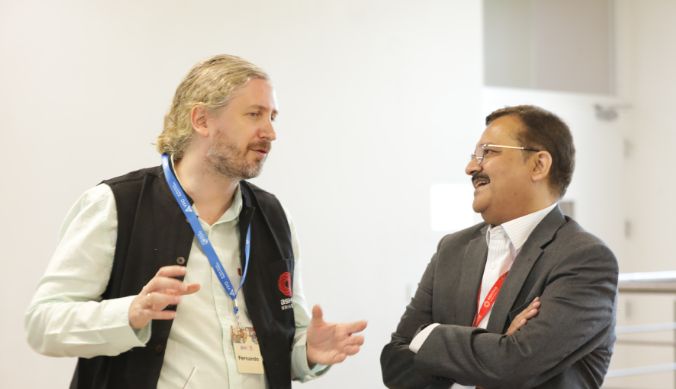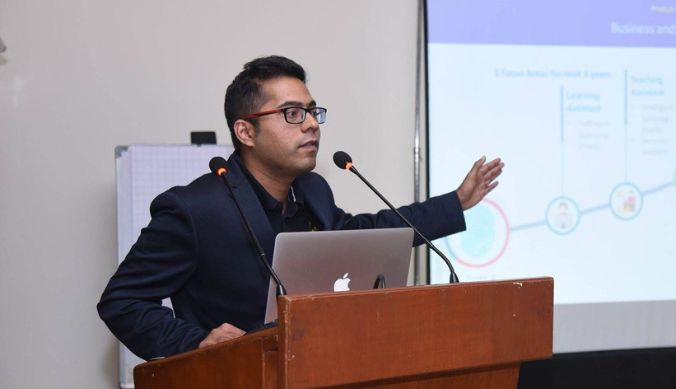#AshokaBookTower – ‘Imagined Geographies in the Indo-Tibetan Borderlands!’ – Inked by Prof Swargajyoti Gohain, Department of Sociology And Anthropology, Ashoka University and published by Amsterdam University Press
The book is an ethnography of culture and politics in Monyul, a Tibetan Buddhist cultural region in west Arunachal Pradesh, Northeast India.

Office of PR & Communications
12 August, 2020 | 6 min readSynopsis:
Imagined Geographies in the Indo-Tibetan Borderlands: Culture, Politics, Place is an ethnography of culture and politics in Monyul, a Tibetan Buddhist cultural region in west Arunachal Pradesh, Northeast India. For nearly three centuries, Monyul was part of the Tibetan state, and the Monpas — as the communities inhabiting this region are collectively known — participated in trans-Himalayan trade and pilgrimage. Following the colonial demarcation of the Indo-Tibetan boundary in 1914, the fall of the Tibetan state in 1951, and the India-China boundary war in 1962, Monyul was gradually integrated into India and the Monpas became a Scheduled Tribe. In 2003, the Monpas began a demand for autonomy under the leadership of Tsona Gontse Rinpoche. This book examines the narratives and politics of the autonomy movement regarding language, place-names, and trans-border kinship against the backdrop of the India-China border dispute. It explores how the Monpas negotiate multiple identities to imagine new forms of community that transcend regional and national borders.
In conversation with the author, Swargajyoti Gohain, Head of the Department, Sociology/Anthropology and Assistant Professor, Sociology and Anthropology.
Please give an insight into ‘Imagined Geographies in the Indo-Tibetan Borderlands: Culture, Politics, Place.’
This book has been a nearly ten-year-long journey for me. I matured intellectually with the writing of the book. I am grateful to Amsterdam University Press for publishing it.
It is an ethnography of Monyul, a Tibetan Buddhist cultural region in west Arunachal Pradesh, Northeast India, which was part of the Tibetan state for almost three centuries and shared ties of trade and religion with Tibet. In 1914, the British colonial rulers drew the Indo-Tibetan boundary, but even after that cross-border exchanges continued until the fall of the Tibetan state in 1951, and the India-China boundary war in 1962, which led to the tighter integration of Monyul with India. In 2003, the Monpas, as the communities inhabiting this region are collectively known, began a demand for autonomy under the leadership of influential monk, Tsona Gontse Rinpoche.
I conducted field studies in Tawang and West Kameng, which are together called Monyul, but the scope of this study extends to other areas on the India-China border. It describes how the Monpas are seeking and building alliances with other Tibetan Buddhist communities across the Himalayas, in Ladakh, Sikkim, Darjeeling etc. All these areas had various commercial and cultural connections with Tibet before 1959, which is when the Dalai Lama came to India as an exile. Regionally marginalised for a long time, these communities are now coming forward to reclaim a cultural identity that draws on their common Tibetan Buddhist traditions. Their call is not for political or territorial unity, i.e. homeland, but for programmatic action and institutionalised protection of Tibetan Buddhism. I call these cultural mobilisations an imagined geography.
What is important is that they substitute “Tibetan” with the politically neutral “Himalayan” while mobilising for Tibetan Buddhist cultural preservation. This has great geopolitical significance, given the sensitive position of Tibet in international relations, and the growing focus on the Himalayan borderlands between India and China.
How is the present scenario for sociological and anthropological research in India right now? Your comment.
Both sociology and anthropology originated in the West around 150 years ago and were introduced in India in the 1920s. Although there is an institutional separation between the two disciplines in most places, at Ashoka University, they are housed in the same Department of Sociology and Anthropology, because we recognise that despite their different origins, they share many connections, and the common method of fieldwork.
There is a growing interest in sociology and anthropology today in India and elsewhere, and anthropology’s methods are increasingly used not only in academia, but also in commerce, media, government and non-governmental organisations. I think this is because anthropology gives meaning to statistical data, helps us see the details and patterns of life, and aids in understanding those who are different from us. Many funding agencies in the Global North reserve funds for anthropological research.
In India too, we have organisations that fund anthropological and other social science research, but they are very less compared to those in the sciences. The quality of anthropological research depends a lot on how much time one is able to spend in the field and engage closely with the people there, their concerns, aspirations, and ideas about the world. So we need more public and private funds for scholars who want to conduct anthropological research in geographically diverse regions, for it is expensive to conduct field studies for long periods of time without financial support.
In this regard, Ashoka University has been very supportive for it understands that research requires quality time and financial aid.
On a side note, Covid-19 has forced a rethinking of some of sociology and anthropology’s primary method, which is on-site fieldwork. Due to the restrictions on travel and large gatherings, many of us have to be creative in our approaches to data collection now, and this is good, because our discipline has evolved over time through innovation and self-reflexivity.
Any anecdote you wish to share.
I will share an anecdote from my fieldwork, which explains the kind of connectivity issues one has to deal with while doing fieldwork in Tawang and West Kameng districts, where the altitude ranges from 4000 to 14,000 feet. Road connectivity from Guwahati (my home town) to Tawang, which borders Tibet, is poor, and is highly dependent on weather conditions. In monsoon or winter, rains or snow often lead to road blocks, and a couple of times, I had to turn back or make an overnight halt half-way because landslides made passage impossible.
The popular form of local transport is the shared Tata Sumo, which is meant for seven passengers but usually crams in eleven and I have a memory of travelling in a Tata Sumo in near-zero visibility fog conditions one night, when both the driver and the passenger next to him had to peer out of the front windows on each side in order to see outside and to keep the car from skidding off the narrow mountain road.
An alternative to road travel is the private helicopter service, which is unpredictable and risky and is often suspended without warning during bad weather, but it can take you to Tawang in 45 minutes while travel by road from Guwahati can take upto 16 hours. Once I remember I was in mid-flight in a rather rickety fourteen-seater helicopter on a cloudy day, and the aircraft failed to establish communication with the helipad in Tawang. I was very concerned to observe the lone flight attendant frantically dialling relatives in Tawang on his cell phone for the latest weather updates. We managed to reach Tawang safely that time. But sadly, what I recount here as memorable travel anecdotes are a daily fact of life for people who live in this part of the country and have to commute on bad roads or through windy skies, when they face emergencies.
What is next in the pipeline?
I have started a research project on Tibetan Buddhist institutions, especially, educational institutions in India. I am interested in two main questions. How can we learn more about the relation between traditional and modern forms of education from the experience of Tibetan Buddhist monastic education? We see that the Tibetan Buddhist institutes of higher learning in India have introduced many changes in their curriculum at the initiative of His Holiness, the Dalai Lama, as well as a response to global forces. I want to study these changes.
Second, I am interested in studying what these educational institutes can tell us about the role of institutional networks in forging cultural identities. I would like to further explore the Himalayan borderlands in India through anthropological research.
Anything else you wish to share.
I feel fortunate to be at an institute like Ashoka University.
I remember when I was a final year doctoral student and starting to think about future career goals, my advisor had asked me where I want to be or see myself after my Ph.D. I had then replied that I wish to teach at a university where I would have bright students to brighten my life and would be able to pursue my research too. Although this seems like a simple wish, it is actually not, for academics find themselves in all kinds of binds and strange situations.
But Ashoka University is a place where you find students who are thoughtful and brilliant, and you also get to pursue your own research passions, for there is so much institutional support for individual research.
To know more about Swargajyoti Gohain, click here.
Reviews of Imagined Geographies in the Indo-Tibetan Borderlands: Culture, Politics, Place
“During the last years we have seen a number of new publications on Northeast India that is based on solid empirical – historical and ethnographic – research. This is a highly welcome development. With Imagined Geographies in the Indo-Tibetan Borderlands we get another great addition. The book concerns a geopolitically highly sensitive place and addresses questions of large scholarly and public interest. It will certainly attract a larger readership.” – Professor Bengt G. Karlsson, Department of Social Anthropology, Stockholm University
“This remarkable ethnography takes us deep into Monyul – as a place, a political construct, and a way of life. Gohain’s rigorous, sensitive research results in a timely interpretation of how ‘Himalayan’ identities are produced in and beyond Arunachal Pradesh. Essential reading for students of borderland lives everywhere.” – Professor Sara Shneiderman, University of British Columbia
Visit the Amsterdam University Press’ page for more information.
About #AshokaBookTower
The newly launched campaign will showcase books written by our faculty and staff members. It aims to highlight the rich variety of subjects and intensive scholarship these books represent. An in-depth conversation with the author also gives a glimpse into what went into the writing of the book. This will a recurring affair and highlights some of the newest launches as well as the old collection.
Do follow us on social media (Facebook | LinkedIn | Twitter | Instagram) to know more about the campaign!













